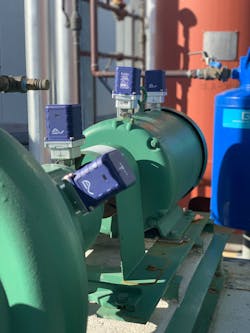The future of artificial intelligence (AI) in manufacturing will be as industry’s partner. We’re already seeing AI-enhanced predictive maintenance that supports new prescriptive maintenance models, enhanced asset and process performance, and increased industry knowledge. With the ability to analyze much larger amounts of data than a human ever could, AI can study the whole system of assets, benefitting individual assets, full operations, and entire industries.
With all the fast-paced advancements AI is making in manufacturing, new developments like generative AI and the cumulative power of AI intelligence are evolving into a new industrial copilot.
Democratizing information access and closing the predictive maintenance loop
“Every function, every role within the main manufacturing space, is going to have a really useful copilot or system. It can have AI applications that enable them not just to do a certain task better or improve a certain aspect of their job, but really have a partner,” says Artem Kroupenev, vice president of strategy at Augury, an industrial AI technology company, offering software and hardware as a service to optimize the health of machines, processes and production.
The dynamic relationship between human and AI can be tremendously scalable, he adds, which means not only performing tasks faster, but also operating in partnership with AI in the decision-making process. Augury refers to this type of AI-enhanced operator system as a copilot, or a “hybrid intelligence of human intelligence combined with artificial augmented intelligence,” Kroupenev says. “We’re seeing the early development of that across manufacturing.”
Generative AI (GenAI) will add another layer to this partnership, one which will steer the relationship two-directional. Manufacturing is uniquely positioned to harness the power of GenAI in a very real way, says Tim Gaus, principal and smart manufacturing lead for Deloitte. “The ability to consume and contextualize different forms of information and bring that into a form where it’s accessible for a much more human interaction is the real unlock,” Gaus says.
GenAI models allow organizations to capture all business intelligence, such as PowerPoint slides, email conversations, reports, meeting transcripts and more, as a base of knowledge accessible to everyone in a searchable format and available to all. “You have this copilot to help access that knowledge of the people,” Gaus says. Deloitte has clients that have invested in private large language models for storing and contextualizing information like equipment manuals and maintenance records, making the information accessible to technicians in a conversational interface and democratizing information access.
AI is the key to the convergence of operational technology (OT) and informational technology (IT) and is making breaking down those siloes easier. Making equipment or processes “smart,” Gaus says, involves understanding how to take an asset in the physical world, bring it into the digital world to do something different or get a different outcome, and then bring that back to the physical world. “It’s creating that closed loop across the two different domains,” he adds.
AI’s collective power to understand the whole system
A system of assets together has more to say than any single asset can individually, and AI can tap into that infrastructure collective easily with enough data. Technology can combine asset condition and process parameters to consider how the manufacturing process affects product quality, or how quality changes under different operating variables.
Asset performance management should include asset failure analysis, but also monitoring product quality and production efficiency through process analysis. “There can be process induced failure in one asset because of an upstream asset or a downstream asset, and what exactly this particular asset is doing in the process actually determines how fast the asset is degrading,” says Nithiya Parameswaran, vice president of product management at Aspen Technology.
Technology can also help manufacturers walk the line between product throughput and quality. If a manufacturer has an asset that’s starting to degrade, but it can’t afford to bring the asset down because it needs to hit production targets and quality standards, then adjusting process parameters with the help of artificial intelligence might get more life out older equipment by sacrificing throughput and maintaining quality. For example, automated adjustments might help extend the likely time to failure for an asset from 60 to 90 days, to leave more room for production interruption or for more time to plan for the inevitable. This also must be a discussion between operations and maintenance, where operations dictates those production targets, and maintenance prescribes a plan to fit the goals.
“What AI does is it provides technology where it automates what we already know,” Parameswaran says. “It’s not going to figure out anything new, but the thing is, it compresses the time to do those tasks.”
Whereas machines typically fail in predictable ways, or in ways that are predictable with enough data, process manufacturing has different objectives. Process optimization is more about product quality and is often very specific to each production line. Product seasonality and product objectives greatly influence line processes. “Even identical processes and identical production lines could have different objectives,” Kroupenev says.
Thus, AI applications need to take those specific applications into account and optimize processes individually. “There are many common denominators across different types of processes, but the way you build the AI solution for process engineering needs to take into account the differences and be flexible enough to be able to provide value across a number of different processes,” Kroupenev adds.
The power of AI also makes prescriptive diagnostics smarter and smarter. Aggregated data across different machines in different industries can constantly improve the quality and accuracy of algorithms, and machine learning is a cumulative and exponential process. AI-enabled equipment is benefitting manufacturers in the field, and the industry-wide increased data value is something new to many original equipment manufacturers (OEMs).
Augury is working with OEMs to embed its AI technology into the machines during design. Most AI applications are retrofitted to older machines, and that will become more and more cost effective as technologies progress. “A lot of the new equipment will come with sensing and the right type of data infrastructure embedded into those machines,” Kroupenev says. Also, many OEMs do not have a view into their equipment in the wild, which can be useful to user and builder. “The equipment manufacturers can utilize some of the statistics that we have anonymized in order to improve the reliability of the equipment that they design and service,” he adds.
Applications from aircraft maintenance to pulp & paper
“We have built an automated data pipeline from our customers into Rolls-Royce, so that they can get real-time or near real-time in-service status of the assets that they’ve built,” says Rob Mather, vice president of aerospace and defense industries at IFS, which develops enterprise software focused on maintenance solutions.
“Predictive maintenance models are all backwards looking, right? That's the historical analysis. And then the next level is when you get the sensor data, and you're doing the anomaly detection to contextualize it around what's actually happening on this specific asset,” Mather says.
Rolls-Royce’s TotalCare program is driven by IntelligentEngine, a digital twin that combines analytics on both physical and digital assets to inform data-driven decisions about maintenance, both for individual customers but also on a wider enterprise scale. The access to massive amounts of customer data all fed to the IntelligentEngine creates the opportunity for AI to build and learn from that database of information.
OEMs can analyze data for the individual operator, but they can also contextualize that data on a broader data set. “They’re not just examining the performance of one customer’s engines, they’re analyzing the performance across their fleet engines to notice trends,” Mather says.
AI technology is also powering asset maintenance. AspenTech worked with Veracel, pulp and paper manufacturer based in Bahia, Brazil, to detect asset failure using AI/ML technology. For Veracel, an upstream liquid ring seal was veering out, so flow fluctuations in the downstream vacuum pump were detected, which could have been attributed to the asset without consideration of process data. Likewise, if the facility didn’t fix that seal, it would slowly get bigger and eventually induce cavitation in the pump, which would eventually cause the pump or bearings to fail.
What started out as a process failure would become an asset failure over time, and AspenTech helped Veracel to use AI/ML technology to see those patterns before they led to asset failure. To start, Veracel focused on AI/ML deployment on three pieces of equipment—a vacuum pump, primary screening equipment, and a recovery boiler fan. Since the initial deployment in 2020, Veracel has extended monitoring to 12 assets in 2022, including additional pumps, filters, screen equipment and drum washers, with plans to scale across 20 assets in the future.
Scaling AI across industries
Augury has seen the use of AI across almost every part of manufacturing, but Kroupenev points to predictive maintenance, and especially process engineering and optimization, as the first real scalable AI use cases. Supply chain optimization is also prime for AI enhancement and is one of the other areas being augmented by AI right now, he says, for production scheduling, warehousing, and inventory management. There are also smaller pockets of growth for AI in areas like sustainability and energy efficiency and safety and compliance.
“We have found that within the machine health space, especially around rotating equipment, after having built enough of a library of different failure modes on different machines, we can see that there are a lot of similarities that actually benefit from economies of scale and having a very large database,” Kroupenev says. To machine learning or artificial intelligence, a pump at one facility is very similar to a pump at a completely different facility or industry.
Deloitte is working with a manufacturing client to use vision systems and its security cameras with an AI neural network to detect and predict likely safety outcomes in operations. Gaus points to the very human impact of how this could change safety culture and the way it is thought about within the manufacturing environment.
Another Deloitte client is using AI in its high-speed manufacturing facility to do predictive analytics for process control. The system requires very low latency, so it needs edge and cloud technology to bring the power of AI in real-time to the plant floor, Gaus says. “They are really pushing the edge of how an artificial intelligence, or at least the predictive nature and the machine learning elements, can intersect day-to-day operations,” he adds.
About the Author

Anna Townshend
managing editor
Anna Townshend has been a journalist and editor for almost 20 years. She joined Control Design and Plant Services as managing editor in June 2020. Previously, for more than 10 years, she was the editor of Marina Dock Age and International Dredging Review. In addition to writing and editing thousands of articles in her career, she has been an active speaker on industry panels and presentations, as well as host for the Tool Belt and Control Intelligence podcasts. Email her at [email protected].


